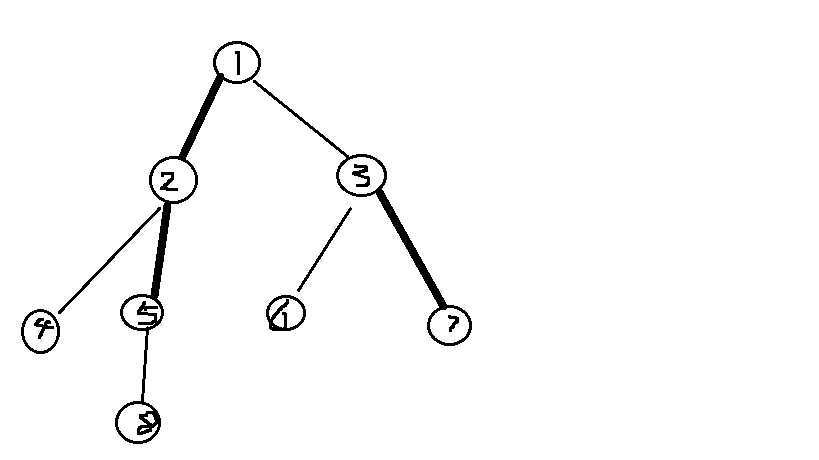动态树之LCT(link-cut tree)讲解
动态树是一类要求维护森林的连通性的题的总称,这类问题要求维护某个点到根的某些数据,支持树的切分,合并,以及对子树的某些操作。其中解决这一问题的某些简化版(不包括对子树的操作)的基础数据结构就是LCT(link-cut tree)。
LCT的大体思想类似于树链剖分中的轻重链剖分(轻重链剖分请移步http://www.cnblogs.com/BLADEVIL/p/3479713.html),轻重链剖分是处理出重链来,由于重链的定义和树链剖分是处理静态树所限,重链不会变化,变化的只是重链上的边或点的权值,由于这个性质,我们用线段树来维护树链剖分中的重链,但是LCT解决的是动态树问题(包含静态树),所以需要用更灵活的splay来维护这里的“重链”(splay请移步http://www.cnblogs.com/BLADEVIL/p/3464458.html)。
定义:
首先来定义一些量:
access(X):表示访问X点(之后会有说明)。
Preferred child(偏爱子节点):如果最后被访问的点在X的儿子P节点的子树中,那么称P为X的Preferred child,如果一个点被访问,他的Preferred child为null(即没有)。
Preferred edge(偏爱边):每个点到自己的Preferred child的边被称为Preferred edge。
Preferred path(偏爱路径):由Preferred edge组成的不可延伸的路径称为Preferred path。
这样我们可以发现一些比较显然的性质,每个点在且仅在一条Preferred path上,也就是所有的Preferred path包含了这棵树上的所有的点,这样一颗树就可以由一些Preferred path来表示(类似于轻重链剖分中的重链),我们用splay来维护每个条Preferred path,关键字为深度,也就是每棵splay中的点左子树的深度都比当前点小,右节点的深度都比当前节点
的深度大。这样的每棵splay我们称为Auxiliary tree(辅助树),每个Auxiliary tree的根节点保存这个Auxiliary tree与上一棵Auxiliary tree中的哪个点相连。这个点称作他的Path parent。
看一个例子

粗的边是Preferred path。那么3-7这个Auxiliary tree中,Path parent为1节点,每个单独的点单独在一棵splay中。以上描述的几个量可以存储这棵树,并且维护相应的信息。
操作:
access(X):首先由于preferred path的定义,如果一个点被访问,那么这个点到根节点的所有的边都会变成preferred edge,由于每个点只有一个preferred child,所以这个点到根节点路径上的所有的点都会和原来的preferred child断开,连接到这条新的preferred path上。假设访问X点,那么先将X点旋转到对应Auxiliary tree的根节点,然后因为被访问的点是没有preferred child的,所以将Auxiliary tree中根节点(X)与右子树的边断掉,左节点保留,将这个树的path parent旋转到对应Auxiliary tree的根节点,断掉右子树,连接这个点与X点,相当于合并两棵Auxiliary tree,不断地重复这一操作,直到当前X所在Auxiliary tree的path parent为null时停止,表示已经完成当前操作。
procedure access(x:longint); var y :longint; begin splay(x);//旋转 while father[x]<>0 do begin y:=father[x]; splay(y); root[son[y,1]]:=true;//son为子节点son[x,0]代表左子结点,son[x,1]代表右子结点 root[x]:=false;//当前点是否为对应Auxiliary tree的根节点 son[y,1]:=x; update(y);//更新y点的信息 splay(x); end; end;
find root(x):找到某一点所在树的根节点(维护森林时使用)。只需要access(X),然后将X节点旋到对应Auxiliary tree的根节点,然后找到这个Auxiliary tree中最左面的点。
function find root(x:longint):longint;
begin
access(x);
splay(x);//将X旋转到根节点
exit(find(x,-maxlongint));//找到子树中最左面的点
end;
cut(x):断掉X节点和其父节点相连的边。首先access(X),然后将X旋转到对应Auxiliary tree的根节点,然后断掉Auxiliary tree中X和左节点相连的边。
procedure cut(x:longint);
begin
access(x);
splay(x);//旋转x点到根节点
father[son[x,0]]:=0;
root[son[x,0]]:=true;//设置左子树根节点
son[x,0]:=-1;
end;
link(join)(x,y):连接点x到y点上。即让x称为y的子节点。因为x为y的子节点后,在原x的子树中,x点到根节点的所有的点的深度会被翻转过来,所以先access(x),然后在对应的Auxiliary tree中将x旋转到根节点,,然后将左子树翻转(splay中的reverse操作),然后access(y),将y旋转到对应Auxiliary tree中的根节点,将x连到y就行了。
procedure link(x,y:longint);
begin
access(x);
splay(x);
reverse(son[x,0]);
access(y);
splay(y);
son[y,1]:=x;
father[x]:=y;
root[x]:=false;
end;
access操作是LCT的基础,应该熟练掌握并且理解。
时间复杂度:
证明access以及其他操作的时间复杂度是均摊log2N的,具体证明参考杨哲的论文《QTREE 解法的一些研究》。
基础题,bzoj 2002:http://61.187.179.132/JudgeOnline/problem.php?id=2002
/************************************************************** Problem: 2002 User: BLADEVIL Language: Pascal Result: Accepted Time:2372 ms Memory:4328 kb ****************************************************************/ //By BLADEVIL var n, m :longint; father, size :array[-1..200010] of longint; son :array[-1..200010,0..2] of longint; root :array[-1..200010] of boolean; procedure update(x:longint); begin size[x]:=size[son[x,0]]+size[son[x,1]]+1; end; procedure left_rotate(x:longint); var y :longint; begin y:=son[x,1]; son[x,1]:=son[y,0]; father[son[x,1]]:=x; son[y,0]:=x; if x=son[father[x],0] then son[father[x],0]:=y else if x=son[father[x],1] then son[father[x],1]:=y; father[y]:=father[x]; father[x]:=y; root[y]:=root[x] xor root[y]; root[x]:=root[x] xor root[y]; update(x); update(y); end; procedure right_rotate(x:longint); var y :longint; begin y:=son[x,0]; son[x,0]:=son[y,1]; father[son[x,0]]:=x; son[y,1]:=x; if x=son[father[x],0] then son[father[x],0]:=y else if x=son[father[x],1] then son[father[x],1]:=y; father[y]:=father[x]; father[x]:=y; root[y]:=root[y] xor root[x]; root[x]:=root[y] xor root[x]; update(x); update(y); end; procedure splay(x:longint); begin while not root[x] do if x=son[father[x],1] then left_rotate(father[x]) else right_rotate(father[x]); end; procedure access(x:longint); var y :longint; begin splay(x); while father[x]<>0 do begin y:=father[x]; splay(y); root[son[y,1]]:=true; root[x]:=false; son[y,1]:=x; update(y); splay(x); end; end; procedure init; var i :longint; begin read(n); for i:=1 to n do begin read(father[i]); father[i]:=father[i]+i; if father[i]>n then father[i]:=n+1; end; read(m); end; procedure main; var i :longint; x, y, z :longint; begin for i:=1 to n+1 do size[i]:=1; fillchar(root,sizeof(root),true); for i:=1 to m do begin read(x); if x=1 then begin read(y); inc(y); access(y); writeln(size[son[y,0]]); end else begin read(y,z); inc(y); splay(y); father[son[y,0]]:=father[y]; root[son[y,0]]:=true; son[y,0]:=0; size[y]:=size[son[y,1]]+1; father[y]:=y+z; if father[y]>n then father[y]:=n+1; end; end; end; begin init; main; end.
posted on 2014-01-08 17:01 BLADEVIL 阅读(24205) 评论(0) 编辑 收藏 举报


